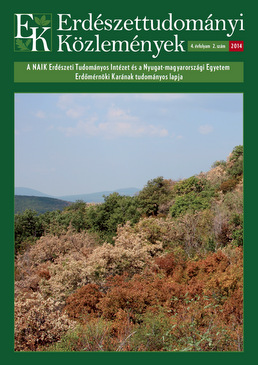| 1. | Arrouays, D.; McKenzie, N.; Hempel, J.; Richer de Forges, A.C. and McBratney, A. (eds) 2014: Global Soil Map. Basis of the global spatial soil information system. Proceedings of the 1st GlobalSoilMap Conference, Orléans France Oct. 2013. CRC Press London. |
| 2. | Dobos, E.; Bialkó, T.; Michéli, E. and Kobza, J. 2010: Legacy Soil Data Harmonization and Database Development. In: Boettinger, J.L.; Howell, D.W.; Moore, A.C.; Hartemink, A.E. and Kienast-Brown, S. (eds): Digital Soil Mapping – Bridging Research, Environmental Application, and Operation [Dordrecht, Heidelberg, London, New York: Springer] (Progress in Soil Science), 309–323. DOI: 10.1007/978-90-481-8863-5_25 |
| 3. | Hengl, T. and Reuter, H.I. (eds) 2007: Geomorphometry Concepts, Software, Application. Developments in Soil Science, 33: 765 pp. |
| 4. | Hengl, T. 2009: A Practical Guide to Geostatistical Mapping. University of Amsterdam, Amsterdam. |
| 5. | Illés G. 2004: Az Észak-Hanság termőhelyi viszonyai és az erdőállományok kapcsolata. Doktori (PhD) értekezés. Sopron. full text |
| 6. | Omuto, C.; Nachtergaele, F. and Rojas, R. V., 2013: State of the Art Report on Glob-al and Regional Soil Information: Where are we? Where to go? Global Soil Part-nership Technical Report. FAO. Rome. |
| 7. | Pásztor, L.; Szabó, J.; Bakacsi, Zs.; Laborczi, A.; Dobos, E.; Illés, G. and Szatmári G. 2014: Elaboration of novel, countrywide maps for the satisfaction of recent demands on spatial, soil related information in Hungary. In: Arrouays et al (eds): Global Soil Map. Orléans, France, 207–212. DOI: 10.1201/b16500-40 |
| 8. | Pásztor, L.; Szabó, J. and Bakacsi, Zs. 2010: Digital processing and upgrading of legacy data collected during the 1:25.000 scale Kreybig soil survey. Acta Geodaetica et Geophysica Hungarica, 45: 127–136. DOI: 10.1556/ageod.45.2010.1.18 |
| 9. | Pásztor, L.; Szabó, J.; Bakacsi, Zs.; László, P. and Dombos, M. 2006: Large-scale Soil Maps Improved by Digital Soil Mapping and GIS-based Soil Status Assessment. Agrokémia és Talajtan, 55(1): 79–88. DOI: 10.1556/agrokem.55.2006.1.9 |
| 10. | Patocskai Z. 2012: Az erdészeti és a mezőgazdasági földértékelési rendszer ökológiai alapjainak összehasonlítása, az egységesítés lehetséges módjai. Doktori (PhD) értekezés, Sopron. full text |
| 11. | Pelikán P. és Peregi Zs. (eds) 2005: Magyarország földtani térképe 1:100000. Magyar Állami Földtani Intézet. |
| 12. | Sanchez, P. A.; Ahamed, S.; Carré, F.; Hartemink, A.E.; Hempel, J.; Huising, J.; Lagacherie, P.; McBratney, A.B.; McKenzie, N.J.; de Mendonca-Santos, M.L.; Minasny, B.; Montanarella, L.; Okoth, P.; Palm, C.A.; Sachs, J.D.; Shepherd, K.D.; Vagen, T.G.; Vanlauwe, B.; Walsh, G.; Winowieczki, L.A. and Zhang, G.L. 2009: Digital soil map of the world. Science, 325: 680–681. DOI: 10.1126/science.1175084 |
| 13. | Sisák, I. and Benő, A. 2014: Probability-based harmonization of digital maps to produce conceptual soil maps. Agrokémia és Talajtan, 63(1): 89–98. DOI: 10.1556/agrokem.63.2014.1.10 |
| 14. | Sisák I. és Bámer B. 2008: Hozzászólás Szabó József, Pásztor László és Bakacsi Zsófia „Egy országos, átnézetes, térbeli talajinformációs rendszer kiépítésének igénye, lehetőségei és lépései” című cikkéhez. Agrokémia és Talajtan, 57(2): 347–354. DOI: 10.1556/agrokem.57.2008.2.9 |
| 15. | Sisák I. és Pőcze T. 2011: A talaj fizikai féleségre vonatkozó adatok harmonizálása egy Balaton környéki mintaterületen. Agrokémia és Talajtan, 60(1): 259–272. DOI: 10.1556/agrokem.60.2011.1.19 |
| 16. | Somogyi, Z.; Bidló, A.; Csiha, I. and Illés, G. 2013: Carbon balance of forest soils of an entire country: a Hungarian countryspecific model based on local case studies. European Journal of Forest Research, 132: 825–840. DOI: 10.1007/s10342-013-0718-x |
| 17. | Szatmári G.; Laborczi A.; Illés G. és Pásztor L. 2013: A talajok szervesanyag-készletének nagyléptékű térképezése regresszió krígeléssel Zala megye példáján. Agrokémia és Talajtan, 62(2): 219–234. DOI: 10.1556/Agrokem.62.2013.2.4 |
| 18. | Tóth, G.; Montanarella, L.; Stolbovoy, V.; Máté, F.; Bódis, K.; Jones, A.; Panagos, P. and van Liedekerke, M. 2008: Soils of the European Union. EUR 23439 EN. Office for Official Publications of the European Communities. Luxembourg. |
| 19. | Waltner, I.; Michéli, E.; Fuchs, M.; Láng, V.; Pásztor, L.; Bakacsi, Zs.; Laborczi, A. and Szabó, J. 2014: Digital mapping of selected WRB units based on vast and diverse legacy data. In: Arrouays, D. et al (eds): Global Soil Map: Basis of the Global Spatial Soil Information SystemTaylor & Francis Group. London, 313–318. DOI: 10.1201/b16500-58 |
